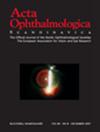Involvement of the neurokinin 1 receptor pathway in aniridia associated keratopathy: Evidence from pre-clinical models
Abstract
Aniridia is a rare ocular disorder characterized by the hypoplasia or absence of the iris associated with severe visual loss. Two-thirds of cases are generated by mutations in the PAX6 gene and are frequently associated with severe aniridia-associated keratopathy (AAK), which is characterized by pain, persistent epitheliopathy, corneal neovascularization and progressive loss of limbal stem cell function. The pathophysiology of AAK is still unclear; however, leukocyte infiltration and nerve degeneration have been reported. Substance P (SP) is a neuropeptide secreted by nerve fibers, immune and epithelial cells in the cornea and exerts its pro-inflammatory functions by binding to neurokinin-1 receptor (NK1R), promoting nerve activation, leukocyte chemotaxis and extravasation, thus contributing to the inflammatory response. In this context, the modulation of NK1R activation could be used as an innovative therapy to control inflammation and pain associated with AAK.
Our main aim was to quantify the expression of NK1R and SP in the cornea of a PAX 6+/− mouse model of AAK compared to unaffected animals at different ages. This model express PAX6 gene in heterozygosis and is characterized by iris hypoplasia, abnormal lens morphology, cataracts, corneal opacification, and incomplete separation of lens from the cornea, typical features associated with AAK patients. Corneal samples were collected from mice at different ages, that is 1 month old, 2 months old, 4 months old, and 7 months old, and immunohistochemistry was performed on cross-sections to quantify the expression of SP and NK1R. In the control samples, NK1R decreased over time albeit not significant. The expression level in the PAX6 +/− samples was comparable to controls at 1, 4, and 7 months old. However, the expression level of NK1R obtained from 2 months old mice was significantly higher compared not only to 1, 4 and 7 months old PAX6 +/− mice but also to all control groups (p < 0.001). The same trend was observed also for SP. Indeed, SP was significantly more expressed in the corneas of 2 months old mice compared to other time points and also to control groups (p < 0.01). These data confirm that the expression of SP goes together with the expression of NK1R during the development of healthy animals. Our data suggest that there may be a window of opportunity for the modulation of SP activity at 2 months of age. Future experiments will be performed in order to investigate the actual efficacy of NK1R blockade for the treatment of AAK.

 求助内容:
求助内容: 应助结果提醒方式:
应助结果提醒方式:


